Continued fractions give the best rational approximations to an irrational number. In this section, we'll see in what sense this is true.
The first lemma says that the denominators of convergents of continued fractions increase.
Lemma. Let ![]() ,
, ![]() ,
, ![]() , ... be a sequence of integers, where
, ... be a sequence of integers, where ![]() for
for ![]() . Define
. Define
![]()
![]()
![]()
Then ![]() for
for ![]() .
.
Proof. Let ![]() . Note that
. Note that ![]() is a positive integer, and
is a positive integer, and ![]() because the a's are positive integers from
because the a's are positive integers from
![]() on. So
on. So
![]()
Theorem. Let x be irrational, and let ![]() be the k-th convergent in the
continued fraction expansion of x. Suppose
be the k-th convergent in the
continued fraction expansion of x. Suppose ![]() ,
, ![]() , and
, and
![]()
Then ![]() .
.![]()
Here's what the result means. Draw the line through the origin in the
t-y plane with slope x. Plot the points ![]() and
and ![]() .
.
The hypothesis ![]() says that
the vertical distance from
says that
the vertical distance from ![]() to
to ![]() is less than the vertical distance from
is less than the vertical distance from
![]() to
to ![]() .
.
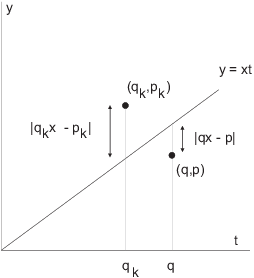
The conclusion says that ![]() . In fact,
since
. In fact,
since ![]() , I have
, I have ![]() : The denominator of
: The denominator of ![]() is bigger than that of
is bigger than that of ![]() .
.
In other words, the only way the point ![]() can be closer to the line is if its
y-coordinate is bigger.
can be closer to the line is if its
y-coordinate is bigger.
Before beginning the proof, I'll note that it is a bit long and technical, though the individual steps aren't hard. I've tried to write out the details carefully, but if the informal discussion above gives you enough of an idea of what the theorem says, you could skip the proof and come back to it later if needed.
Proof. I'll give a proof by contradiction.
Suppose that ![]() .
.
Consider the equations
![]()
u and v are defined as the solutions to these equations.
Think of this in matrix form:
![]()
Using an earlier result on convergents, the determinant of the coefficient matrix is
![]()
This means that when I solve the matrix equation by inverting the coefficient matrix, I get
![]()
The point is that u and v are integers.
I'll now establish the contradiction in a series of steps.
Step 1. ![]() and
and ![]() .
.
Suppose ![]() . Then
. Then ![]() gives
gives ![]() , so
, so
![]()
Also, ![]() gives
gives ![]() , so
, so
![]()
That is,
![]()
Thus, ![]() . But
. But ![]() (as
(as ![]() and
and ![]() are the numerator and the denominator of a
convergent), so
are the numerator and the denominator of a
convergent), so ![]() . This is
a contradiction, because I'm assuming that
. This is
a contradiction, because I'm assuming that ![]() . This proves that
. This proves that ![]() .
.
Suppose ![]() . Then
. Then ![]() gives
gives ![]() . Also,
. Also, ![]() gives
gives ![]() . Hence,
. Hence,

This implies ![]() , which contradicts
, which contradicts ![]() established above. Hence,
established above. Hence, ![]() .
.
Step 2. u and v have opposite signs.
Since ![]() , either
, either ![]() or
or ![]() .
.
Suppose ![]() . Then
. Then ![]() , so
, so
![]()
Then ![]() gives
gives
![]()
Since ![]() , I must have
, I must have ![]() . Hence, u and v have opposite signs in
this case.
. Hence, u and v have opposite signs in
this case.
Suppose ![]() . Then
. Then ![]() , so
, so ![]() . Therefore,
. Therefore,
![]()
Since ![]() , I have
, I have ![]() . Hence, u and v have opposite signs in
this case.
. Hence, u and v have opposite signs in
this case.
Step 3. ![]() and
and ![]() have opposite signs.
have opposite signs.
The value x of the infinite continued fraction lies between any two consecutive convergents. Hence, either
![]()
If ![]() , the first inequality gives
, the first inequality gives ![]() , so
, so ![]() . The second inequality gives
. The second inequality gives ![]() , so
, so ![]() . Hence,
. Hence, ![]() and
and ![]() have opposite signs in this
case.
have opposite signs in this
case.
If ![]() , the first inequality gives
, the first inequality gives ![]() , so
, so ![]() . The second inequality
gives
. The second inequality
gives ![]() , so
, so ![]() . Hence,
. Hence, ![]() and
and ![]() have opposite signs in this
case.
have opposite signs in this
case.
Step 4. ![]() and
and ![]() have the same sign.
have the same sign.
This follows from Steps 2 and 3 by checking the possible combinations of (opposite) signs:

Step 5. (Final contradiction) Since ![]() and
and ![]() have the same sign,
have the same sign,
![]()
Therefore, using the defining equations for u and v to substitute for p and q, I get
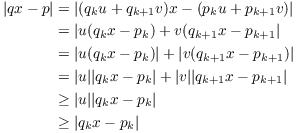
It has been a while, but you may still remember that a hypothesis of
this theorem was ![]() . So we have our contradiction, and it follows that
. So we have our contradiction, and it follows that ![]() .
.![]()
Corollary. Let x be irrational, and let ![]() be the k-th
convergent in the continued fraction expansion of x. Suppose
be the k-th
convergent in the continued fraction expansion of x. Suppose ![]() ,
, ![]() , and
, and
![]()
Then ![]() .
.
Proof. Given the hypotheses of the corollary,
suppose on the contrary that ![]() . Multiply this inequality by
. Multiply this inequality by
![]()
I get
![]()
Apply the theorem to obtain ![]() . But then
. But then ![]() , which contradicts the fact that
the q's increase.
, which contradicts the fact that
the q's increase.
Therefore, ![]() .
.![]()
This result says that the only way a rational number ![]() can approximate a continued fraction
better than a convergent
can approximate a continued fraction
better than a convergent ![]() is if the fraction has a bigger
denominator than the convergent.
is if the fraction has a bigger
denominator than the convergent.
For example, consider the convergents for the continued fraction
expansion of ![]() :
:
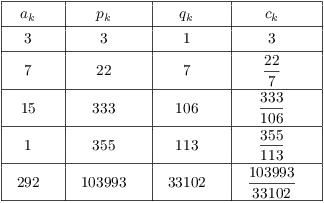
![]() , which is
in error in the seventh place. The theorem says that a fraction
, which is
in error in the seventh place. The theorem says that a fraction ![]() can be closer to
can be closer to ![]() than
than ![]() only if
only if
![]() .
.
The next result is sort of a converse to the previous two results. It says that if a rational number approximates an irrational number x "sufficiently well", then the rational number must be a convergent in the continued fraction expansion for x.
Theorem. Let x be irrational, and let ![]() be a rational number in lowest terms with
be a rational number in lowest terms with
![]() . Suppose that
. Suppose that
![]()
Then ![]() is a
convergent in the continued fraction expansion for x.
is a
convergent in the continued fraction expansion for x.
Proof. Since ![]() for
for ![]() , the q's form a strictly increasing
sequence of positive integers. Therefore, for some k,
, the q's form a strictly increasing
sequence of positive integers. Therefore, for some k,
![]()
Since ![]() , the contrapositive of
the preceding theorem gives
, the contrapositive of
the preceding theorem gives
![]()
Hence,
![]()
Now assume toward a contradiction that ![]() is not a convergent in the
continued fraction expansion for x. In particular,
is not a convergent in the
continued fraction expansion for x. In particular, ![]() , so
, so ![]() , and hence
, and hence ![]() is a positive integer.
is a positive integer.
Since ![]() ,
,
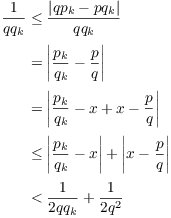
(The second inequality comes from the Triangle Inequality: ![]() .)
.)
Subtracting ![]() from
both sides, I get
from
both sides, I get

But I assumed ![]() , so this is a
contradiction.
, so this is a
contradiction.
Therefore, ![]() is a
convergent in the continued fraction expansion for x.
is a
convergent in the continued fraction expansion for x.![]()
Example. Show that ![]() is the best rational approximation
to
is the best rational approximation
to ![]() by a fraction having a denominator less than
1000.
by a fraction having a denominator less than
1000.
Suppose that ![]() is a fraction
in lowest terms that is a better approximation to
is a fraction
in lowest terms that is a better approximation to ![]() than
than ![]() , and
that
, and
that ![]() .
.
Since ![]() is a fraction
is a better approximation to
is a fraction
is a better approximation to ![]() than
than ![]() ,
,
![]()
Since ![]() ,
,

But
![]()
Thus,
![]()
The hypotheses of the theorem are satisfied, so ![]() must be a convergent in the continued
fraction expansion of
must be a convergent in the continued
fraction expansion of ![]() .
.
But the other convergents with denominators less than 1000 --- 3,
![]() ,
, ![]() --- with denominators less than
1000 are poorer approximations to
--- with denominators less than
1000 are poorer approximations to ![]() than
than ![]() .
.
Hence, ![]() is the
best rational approximation to
is the
best rational approximation to ![]() by a fraction having a denominator less than
1000.
by a fraction having a denominator less than
1000.![]()
Example. (a) Compute the first 6 convergents
![]() , ...
, ... ![]() of the continued fraction for
of the continued fraction for ![]() .
.
(b) Show that ![]() is the
best rational approximation to
is the
best rational approximation to ![]() having denominator less than 155.
having denominator less than 155.
(a)
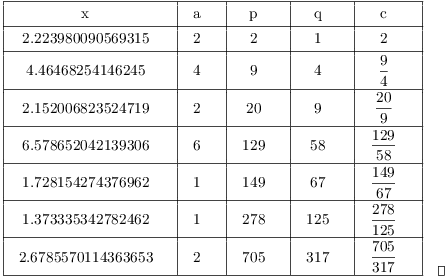
(b) Suppose that ![]() is a fraction
in lowest terms which is a better approximation to
is a fraction
in lowest terms which is a better approximation to ![]() than
than ![]() , and also that
, and also that ![]() .
.
Since ![]() is a better
approximation to
is a better
approximation to ![]() than
than ![]() ,
,
![]()
Since ![]() ,
,
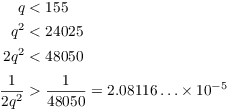
So I have
![]()
(The inequalities are approximate, but there is enough room between
![]() and
and ![]() that there is no
problem.)
that there is no
problem.)
By the approximation theorem, ![]() is a convergent for
is a convergent for ![]() . But no convergent with
. But no convergent with ![]() is a better approximation than
is a better approximation than ![]() .
.
This contradiction shows that ![]() is the best rational approximation
to
is the best rational approximation
to ![]() having denominator less than
155.
having denominator less than
155.![]()
Copyright 2019 by Bruce Ikenaga